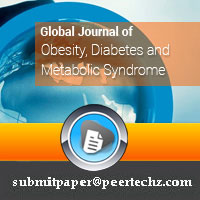Global Journal of Obesity, Diabetes and Metabolic Syndrome
Reversible blindness associated with severe Diabetic Ketoacidosis
Jitendra Pareek1 and Jayesh Trivedi2*
2Professor and Head, Department of Medicine, Gujarat Adani Institute of Medical Science, Bhuj, Gujarat, India
Cite this as
Pareek J, Trivedi J (2017) Reversible blindness associated with severe Diabetic Ketoacidosis. Glob J Obes Diabetes Metab Syndr 4(3): 066-067. DOI: 10.17352/2455-8583.000027Diabetes mellitus is commonly associated with gradual onset of visual loss. Reversible acute blindness associated with diabetic ketoacidosis has been reported only once previously .Metformin associated blindness is common in type 2 diabetes patients but in type 1 diabetes patients gradual loss of vision is commonly due to proliferative diabetic retinopathy.
Case Report
We report a case of sudden onset reversible blindness associated with diabetic ketoacidosis. A male patient aged 18 years, was admitted to General Hospital, Bhuj on 2nd December, 2015 with abdominal pain and vomiting. The patient was a diagnosed case of type1 diabetes for the last 4 years. Physically examination revealed a gangrenous ulceration over the right foot.
On admission patient’s Random Blood Sugar – 429mg/dl, white blood cell count- 18,600, Creatinine- 1.5, Liver function test was normal,urine routine-micro -normal, urine sugar was 4+ and urine acetone was large. First day, after giving insulin and fluids, patient was better and out of Diabetic ketoacidosis. On second day evening, patient complained of abdominal pain, vomiting and eventually lapsed in Diabetic ketoacidosis. Treatment was done according to DKA management protocol.
On third day, early morning patient was complaining of sudden loss of vision with negative history of any methanol ingestion, trauma or vascular event .An ophthalmology review revealed clear corneas, normal fundoscopy and no local cause for loss of vision..CT brain was also normal. Arterial Blood Gas report showing severe metabolic acidosis with pH- 7.12, pCO2-16kPa, HCO3- -5.1mEq/L, Na+-126mEq/L , K+2.3mEq/L.
Patient again lapsed in Diabetic Keto Acidosis. Correction of acidosis was done with sodium Bicarbonate and patient had improved his vision and was feeling better after 5 hours of treatment. His Arterial Blood Gas was showing pH-7.41, PCO2-38kPa, HCO3--26 mEq/L, Na+130 mEq/L, K+3.1 mEq/L.
Correction of acidosis leads to improvement in vision of patient and he was better all throughout the hospital stay. On 12th December, patient was discharged with injection mixtard insulin (30/70) and advised with daily dressing of diabetic foot.
Discussion
Common non-metabolic causes of sudden onset of blindness include trauma and vascular injury where the reversibility of blindness is not related to the arterial pH of blood. The course of sudden onset of complete blindness with normal fundoscopy examination and head computed tomography, negative history of any methanol ingestion trauma or vascular event and rapid return of full vision once the arterial pH was > 7.0 after correction of acidosis, strongly suggests that diabetic ketoacidosis was the causative factor for the blindness in this case. A similar case of transient reversible blindness due to diabetic ketoacidosis has been reported by Deutsch [1]. Also, other cases of similar presentation have been reported where alcoholic ketoacidosis was found to be the reason for severe metabolic acidosis [2,3]. The common aspects in all of these cases are a severe metabolic acidosis with an arterial pH < 7.0 and a rapid reversal of blindness with correction of the acidosis. The exact mechanism whereby a severe metabolic acidosis causes reversible blindness is uncertain. However, studies on fish and salamander by Feeney et al [2]. Describe a possible explanation: extracellular acidification to a pH < 7.0 uncouples the horizontal cells, preventing the transmission of photoreceptor information into the visual neuronal network.
Conclusion
Acute blindness is reversible in diabetic ketoacidosis patient which is mainly due to metabolic acidosis. Correction of metabolic acidosis leads to improvement of vision. It should be considered as a differential diagnosis in patients of Diabetes Mellitus presented with acute blindness.
- Deutsch GA (1981) Transient blindness associated with severe diabetic ketoacidosis. Minn Med 64: 201. Link: https://goo.gl/Jrp4Av
- Feeney C, Muller M, Bryzman S, Nakada T (1998) Reversible blindness associated with alcoholic ketoacidosis: pseudo methanol intoxication. J Emerg Med 16: 597–599. Link: https://goo.gl/R47wrN
- Yanagawa Y, Kiyozumi T, Hatanaka K, Itoh T, Sakamoto T, et al. (2004) Reversible blindness associated with alcoholic ketoacidosis. American Journal of Ophthalmology 2004; 137: 775–7. Link: https://goo.gl/gVR2H6
Article Alerts
Subscribe to our articles alerts and stay tuned.
 This work is licensed under a Creative Commons Attribution 4.0 International License.
This work is licensed under a Creative Commons Attribution 4.0 International License.

 Save to Mendeley
Save to Mendeley
